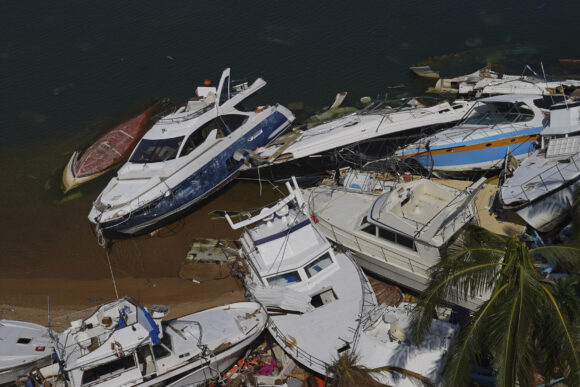Moody’s RMS, the risk modeling and solutions company, estimates private market insured losses from Hurricane Otis to range between US$2.5 billion and US$4.5 billion. On the other hand, Verisk puts insured losses at US$3 Billion to US$6 Billion.
The estimated insured losses are primarily the result of wind damage from the category 5 storm that hit Acapulco, Mexico on Wednesday, Oct. 25, 2023.
“Damage to coastal and inland exposures in and around Acapulco was catastrophic,” said Verisk in a statement issued on Nov. 1.
“Insured losses from Otis will be driven by wind damage with minor contribution from storm surge and precipitation-induced flooding. Insured wind losses will be predominantly for commercial lines, including commercial multi-family dwellings, hotels, resorts, and high-rise buildings that have been severely affected in this event,” according to Moody’s RMS in a statement issued on Nov. 13.
Moody’s RMS said its estimate reflects property damage and business interruption losses to residential, commercial, industrial, and automobile lines of business, and considers potential for post-event loss amplification (PLA), inflationary trends, and non-modeled sources of loss, including infrastructure damage. However, the estimate does not include losses for any sovereign protection programs (Mexico’s FONDEN), which include both traditional re/insurance and insurance-linked securities.
“Major Hurricane Otis was an unprecedented event across multiple fronts. As a Category 5 storm with 165 mph sustained winds, it was the strongest landfalling hurricane on record in both the Acapulco region and Mexico as a whole, aided by a period of record rapid intensification in the 24 hours prior to landfall,” commented Jeff Waters, staff product manager, North Atlantic Hurricane Models, Moody’s RMS.
Prior to Otis, this region of Mexico had never previously experienced a Category 5 hurricane landfall, he noted.
“In determining the overall damage estimates from this event, underinsurance is a common theme. Much of the damaged exposure is unlikely to be insured to the full value of the structure or insured at lower limits, especially in inland regions,” said Julie Serakos, senior vice president, Moody’s RMS.
“We expect most of the insured losses to be driven by damage to coastal commercial and commercial residential exposure. Nevertheless, we expect Otis to be one of the costliest hurricanes in Mexico history from both an economic and insured loss perspective,” Serakos added.
Otis Likely to Be One of Costliest Hurricanes for Mexico Insurance Market: Gallagher Re
“Insurance takeup for residential risks is quite low in Mexico, though a bit higher for commercial risks. However, it is likely there is higher residential insurance take up in Acapulco, particularly in direct coastal areas, than across the rest of the state of Guerrero,” according to Verisk.
“The strongest winds from the event caused damage to a large stretch of modern, high-rise exposure along Acapulco Bay, including apartment complexes, hotels, and resorts,” said Rajkiran Vojjala, vice president, Model Development, Moody’s RMS.
“Aerial imagery and reconnaissance to date show that Otis caused some of the most incredible wind damage to modern-day high-rise structures we have ever seen, as observed winds well-exceeded prevalent design wind speeds for the region,” Vojjala added.
“While several tall buildings survived record gusts, thanks to well-designed structural systems in place for earthquake safety, their lightweight cladding and exterior that improves seismic performance, bore the brunt of high winds, and was destroyed,” he said. “Recovery and reconstruction efforts could take years. During this time, we expect a high number of total constructive losses given the damage severity and complexity of repairs.”
“The coastline of Acapulco contains many larger apartments and condominium buildings as well as hotels. Many of those had a majority of the windows blown out by Otis’s devastating winds. Roof covering damage was also noted on many buildings near the coast. Smaller commercial and residential buildings in Acapulco saw major damage as well, with cladding tossed from walls, roofs torn off and debris scattered,” Verisk said. “Significant damage was also observed to the north and west of Acapulco. In Coyuca de Benitez, Guerrero, there was minor damage to a hospital as well as significant damage to residential structures observed.”
Included in Verisk’s industry insured loss estimate are losses to onshore residential, commercial and industrial properties and automobiles for their building, contents and time element coverage from wind and precipitation induced flood.
Verisk said its modeled insured loss estimates do not consider:
- Losses paid out by any sovereign or government protection programs
- Losses from coastal storm surge
- Losses to inland marine, ocean-going marine cargo and hull, and pleasure boats/yachts
- Losses to uninsured properties
- Losses to infrastructure
- Losses from extra-contractual obligations
- Losses from hazardous waste cleanup, vandalism or civil commotion, whether directly or indirectly caused by the event
- Loss adjustment expenses
Hurricane Otis was the 15th named storm of the 2023 Pacific Hurricane Season, the 10th hurricane, and the 8th major hurricane. Otis was the first Category 5 hurricane to make landfall on the west coast of Mexico since recordkeeping began, Moody’s RMS said.
The 2023 Pacific hurricane season officially ends on Nov. 30.
Hurricane Otis’ Storm Track
Hurricane Otis first became a tropical depression on Sunday, Oct. 22, with forecasts at the time predicting it would not reach hurricane strength nor reach land, according to Verisk, in a description of the storm’s meteorological history. At 1:00 am local time on Tuesday, Oct. 24, Otis remained a tropical storm with maximum sustained winds of 50 mph. As Otis continued to strengthen that morning, the official forecast was increased to bring the cyclone to hurricane intensity by landfall. Early that afternoon the storm had maximum sustained winds at 110 mph.
The storm intensified “at a remarkable pace over the next several hours,” which meant that Otis increased its maximum winds by 115 mph in just 25 hours, Verisk said.
On Wednesday, Oct. 25, Hurricane Otis made landfall near Acapulco, on Mexico’s southern Pacific coast, at 1:25 a.m. CDT as a Category 5 hurricane with sustained winds of 165 mph, according to the National Oceanic & Atmospheric Administration (NOAA).
By 4 p.m. on Wednesday, Oct. 25, the National Hurricane Center downgraded Otis to a tropical depression and issued its final advisory on the storm, just 15 hours after it reached the Pacific coast of Mexico as the strongest landfalling hurricane on record in this region, Verisk added.
Various news reports indicate that 48 people died as a result of the storm.
Source: Moody’s RMS and Verisk
Photograph: Boats lay in ruins after the passing of Hurricane Otis in Acapulco, Mexico, on Sunday, Nov. 12, 2023. (AP Photo/Marco Ugarte)
Related:
Was this article valuable?
Here are more articles you may enjoy.



 Buffett’s Berkshire Reveals $6.7 Billion Stake in Insurer Chubb
Buffett’s Berkshire Reveals $6.7 Billion Stake in Insurer Chubb  Nuclear Verdicts Surge to $14.5 Billion in 2023 – Report
Nuclear Verdicts Surge to $14.5 Billion in 2023 – Report  Swiss Re to Withdraw From Digital Insurer iptiQ, Reports Strong Q1 Net Income of $1.1B
Swiss Re to Withdraw From Digital Insurer iptiQ, Reports Strong Q1 Net Income of $1.1B  After Two Years in the Eye of the Storm, Neal Steps Down From FIGA. Brown Up Next
After Two Years in the Eye of the Storm, Neal Steps Down From FIGA. Brown Up Next 

